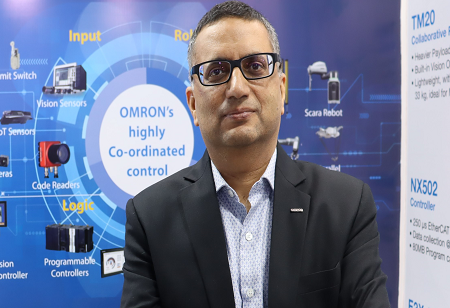
In a recent interaction with Industry Outlook, Sameer shared his thoughts on the current manufacturing sector in India and how industrial automation solutions have been reshaping the industry.
Sameer Gandhi, having completed his engineering degree in Instrumentation from Savitribai Phule Pune University, is a seasoned industry professional with over three decades of experience across marketing, sales, operations, project management, and P&L leadership. He has been associated with OMRON for over a decade now, before which he held the position of Vice President at ABB India.
How is industrial automation equipment reshaping the Indian manufacturing sector?
Currently, the Indian manufacturing sector is at an inflection point, wherein manufacturing has picked up significantly over the last few years. The momentum that was built over the last couple of decades has reached a point today where the volumes have become sizable. The current geopolitical scenario is favoring us; the government has launched various PLI schemes that are enabling us to take advantage of the shifts. Today, Indian manufacturing needs to produce goods of world-class quality and productivity to meet customer aspirations as well as compete against foreign players. The supply chain risk mitigation strategy of multi-nationals, spurred by the US-China trade war and accelerated by COVID, is further driving manufacturing to India. Also, during the COVID pandemic, most manufacturing companies realized that dependency on manpower needed to be reduced to avoid disruptions. This is where automation comes into play, wherein automating a manufacturing setup results in increased productivity, enhanced quality, and reduced energy consumption. These three factors are being directly impacted by automation solutions deployed in manufacturing setups across all industries, leading to transformation and change.
Throw some light on the key areas in Indian manufacturing that show the maximum potential for swift integration of automation.
Since all areas of Indian manufacturing are equally ready for the shift towards greater automation, it is difficult to point to one particular area. But from a traditional viewpoint, manufacturing in some sectors has been automated more than others. For instance, the automotive sector has had a higher level of automation than the F&B or FMCG industries, and this is largely due to the nature of the manufacturing process. While there is no doubt that all manufacturing industries can benefit immensely from greater automation, the areas that can gain the most are the ones where there is a higher level of reliability in people for quality and productivity management. Handing naked food (raw or fried fish or ready-to-eat food products) is the best example of this, where restricting human presence is paramount to maintaining hygiene and quality.
Briefly explain the importance of collaborations between automation machinery manufacturers and Indian manufacturing companies.
Whatever the automation equipment suppliers do is not done in isolation. For example, Omron’s application engineers collaborate with the customer, get a clear understanding of their pain points, and accordingly build a tailored solution to mitigate those challenges. This also helps manufacturing companies derive maximum ROI for their automation investments.
What are some of the primary hurdles preventing widespread automation adoption in Indian manufacturing?
Apart from price, the biggest challenge for widespread adoption of automation is implementation partners. Since there can be many uncertainties in implementing automation in any manufacturing setup, there is a dire need for a robust system integrator environment. For example, if one wants to implement a robotic solution, we need a solution partner or system integrator who has good knowledge and experience in mechatronics, robotics, and other control systems, along with being able to clearly understand the client's requirements and accordingly build a solution around them. These are the qualities that are not very easily available, which makes them one of the most critical bottlenecks when implementing automation in a manufacturing setup.
Enlighten us about the customization factor in automation equipment.
The products remain standard for all sectors, be they automotive OEMs or any other ancillary industry. However, the solutions can be customized and vary depending on the size and dimension. Also, while some solutions, such as those for traceability, will be common across all industries, the scale and number of components that are covered could be different.
We use cookies to ensure you get the best experience on our website. Read more...